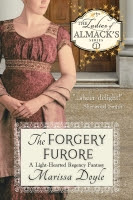So far, the grandchildren of Queen Victoria that we’ve met have lived fairly dramatic lives as heads of state or embroiled in tumultuous times. But some of them lived much quieter, though in their own way, equally dramatic existences. One of those was Princess Marie Louise of Schleswig-Holstein.
Despite her Germanic sounding title, Marie Louise (christened Franziska Josepha Louise Augusta Marie Christina Helena) was born and raised in England, the fourth and last surviving child of Princess Helena and her husband, Prince Christian of Schleswig-Holstein, who (as you may recall) had consented to stay in England so that the Queen would not lose the services of Helena as a sort of glorified secretary. And so Marie Louise (born August 12, 1872) and her two older brothers and older sister Helena Victoria (called Thora--that's the two of them at right) grew up at Cumberland Lodge near Windsor, with the typical privileged upbringing of the time and an education focusing on speaking French and German nicely and a smattering of history and literature, with more focus on dancing, sketching, and deportment. There were visits to country houses, to Balmoral and Osborne to stay with Grandmama the Queen and to various relations in royal families around Europe—Marie Louise was especially close to her cousin Alix of Hesse, who would one day become the last Tsarina of Russia.
And then in 1889 when she was eighteen, Marie Louise went to Berlin for yet another cousin’s wedding and met a tall, handsome young cavalry officer, Prince Aribert of Anhalt. To the bedazzled girl’s delight he paid her a great deal of flattering attention, and she fell head over heels in love. Though her cousin Emperor Wilhelm tried to fix her up with another royal suitor, Ferdinand of Roumania (who would go on to marry another English Marie), Marie Louise had made up her mind, and Wilhelm good-naturedly arranged matters so that Aribert proposed the following year. They were married in July 1891.
Anhalt was a not-terribly important duchy in east-central Germany, and was delighted to get a grand-daughter of Queen Victoria (and cousin of Emperor William) as its future duchess. Marie Louise loved her new mother-in-law and was fond of her father-in-law the Duke, though she regarded him as not very bright. Etiquette was very strict in her new home and throughout Germany, which rather chafed the lively young woman, accustomed to a more relaxed family life at home in Cumberland Lodge. She took refuge in travel, sometimes with Aribert and sometimes without, and took extended visits to Italy, Tunis, and Algiers. That she traveled without Aribert became more and more common: almost from their wedding day, Aribert always seemed busy elsewhere, and weeks might pass without their seeing each other. It’s hardly surprising that the couple had no children, which might have reconciled Marie Louise to her loneliness—instead, she continued to travel and busy herself with her network of friends (and no, that did not include any romantic entanglements. Marie Louise remained a faithful wife.) So when on her doctor’s orders she took a long sea voyage to visit the United States and Canada, she went only with her lady-in-waiting…and was surprised to receive a curt telegram in Ottawa from her father-in-law, ordering her home at once. It was rapidly followed by one from Queen Victoria reading, “Tell my granddaughter to come home to me. VR.”
Marie Louise went home to Grandmama—and found out to her shock that in her absence, her father-in-law had declared her marriage to Aribert annulled, because Aribert felt he could no longer live with her. There has been speculation that he was perhaps gay, but no one will ever know…and now, for all intents, poor Marie Louise was once again single. Though legally her marriage had been dissolved, Marie Louise still regarded herself as a married woman in the eyes of the church, and never remarried—nor did Aribert.
And that was that. She moved home again, continued to travel extensively (that's her at right on a trip to the Gold Coast in the 1920s), took up enameling and jewelry making as a hobby, and gave generously of her time to various charitable endeavors, including nursing and hospital work, a home for lepers, a Girls’ Club in a poor section of London, and other poor relief projects. She also headed up the doll house project for her childhood friend, Queen Mary. After her parents’ deaths, she and Thora (who never married) lived together, busy with their friends and family and charitable activities. Marie Louise lived long enough to see the present queen, Elizabeth, crowned in 1953, published a charming memoir called My Memories of Six Reigns, and died in 1956.
Subscribe to:
Post Comments (Atom)








No comments:
Post a Comment